Newsletter: Why are unions clashing with the solar industry over clean energy batteries?
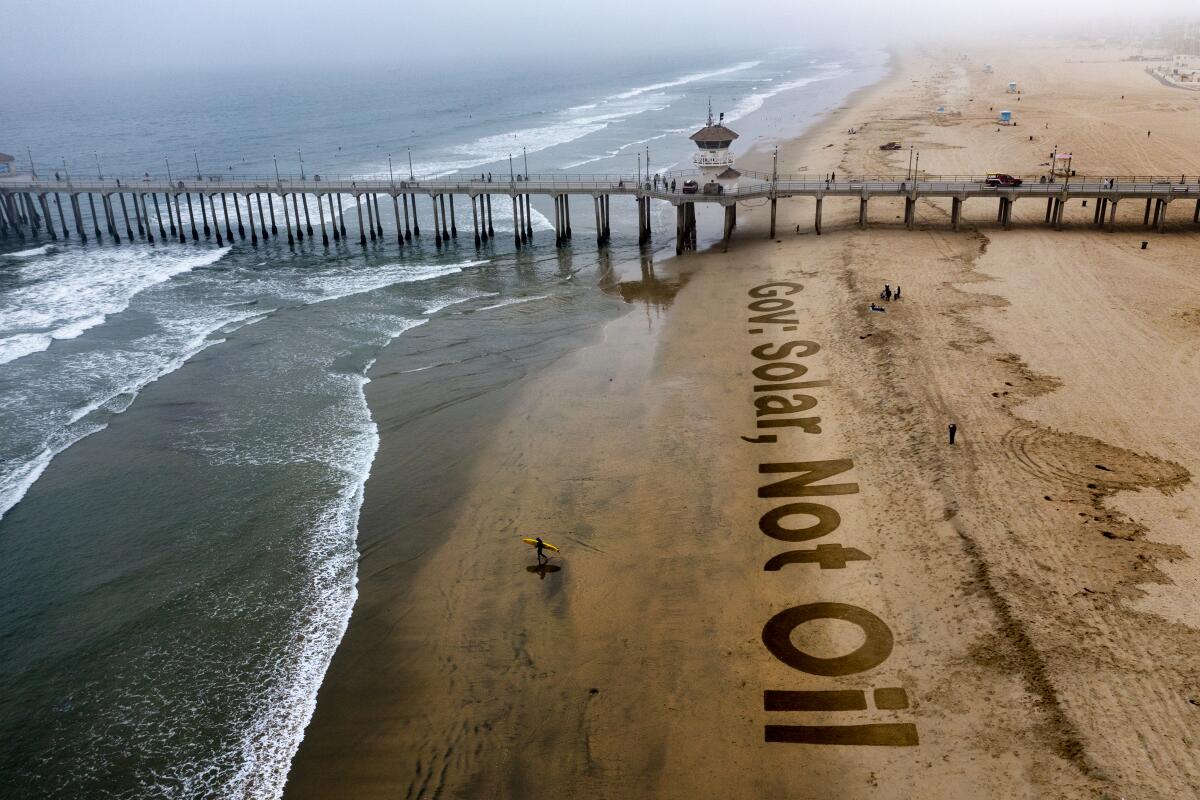
- Share via
This is the Nov. 11, 2021, edition of Boiling Point, a weekly newsletter about climate change and the environment in California and the American West. Sign up here to get it in your inbox.
Until recently, I had never heard of the Contractors State License Board, or CSLB. It’s a California agency that regulates the construction industry, with a goal of protecting public health and safety. Most of its 15 members are appointed by the governor.
Why am I telling you this? Because CSLB sent shock waves through the solar industry this summer when it ruled that rooftop solar companies would no longer be allowed to install batteries — an increasingly popular tool for keeping the lights on during blackouts — without getting a new license that might require them to overhaul their workforce. Solar industry leaders were apoplectic, saying the new requirement would be impossible to meet and would crash the market. They filed a lawsuit to block it.
The groups pushing the rule change framed it as a safety issue. By requiring solar companies to use certified electricians to handle battery installations, they’ve argued, state officials can limit the risk of lithium-ion battery fires, explosions and other hazards.
So on the surface, at least, this is a technical dispute over battery safety and workforce training requirements. But just below the surface lurks a long-simmering conflict between the rooftop solar industry and organized labor.
If that sounds familiar, well, you probably read my latest story (which I still hope you’ll subscribe to The Times to access, if you haven’t already), or last week’s edition of Boiling Point. In both pieces, I noted that most rooftop solar jobs are nonunion, unlike most jobs building large-scale solar farms. It’s a reality that has created constant tension in California, with politically powerful electrical and building trades unions pushing lawmakers to support big solar farms at the expense of rooftop installations.
The ongoing dispute over contracting standards is a revealing example of that tension.
The idea of barring most rooftop solar companies from installing batteries — unless they also obtain an electrical contractor’s license, which requires employees performing electrical work to be certified electricians — was first proposed by the International Brotherhood of Electrical Workers and the National Electrical Contractors Assn., whose member companies hire IBEW workers.
“We can’t comply with this. People will go out of business,” said Bernadette Del Chiaro, executive director of the California Solar and Storage Assn. “Prices will go up, and we’ll lose the ability to meet customer demand for clean energy.”
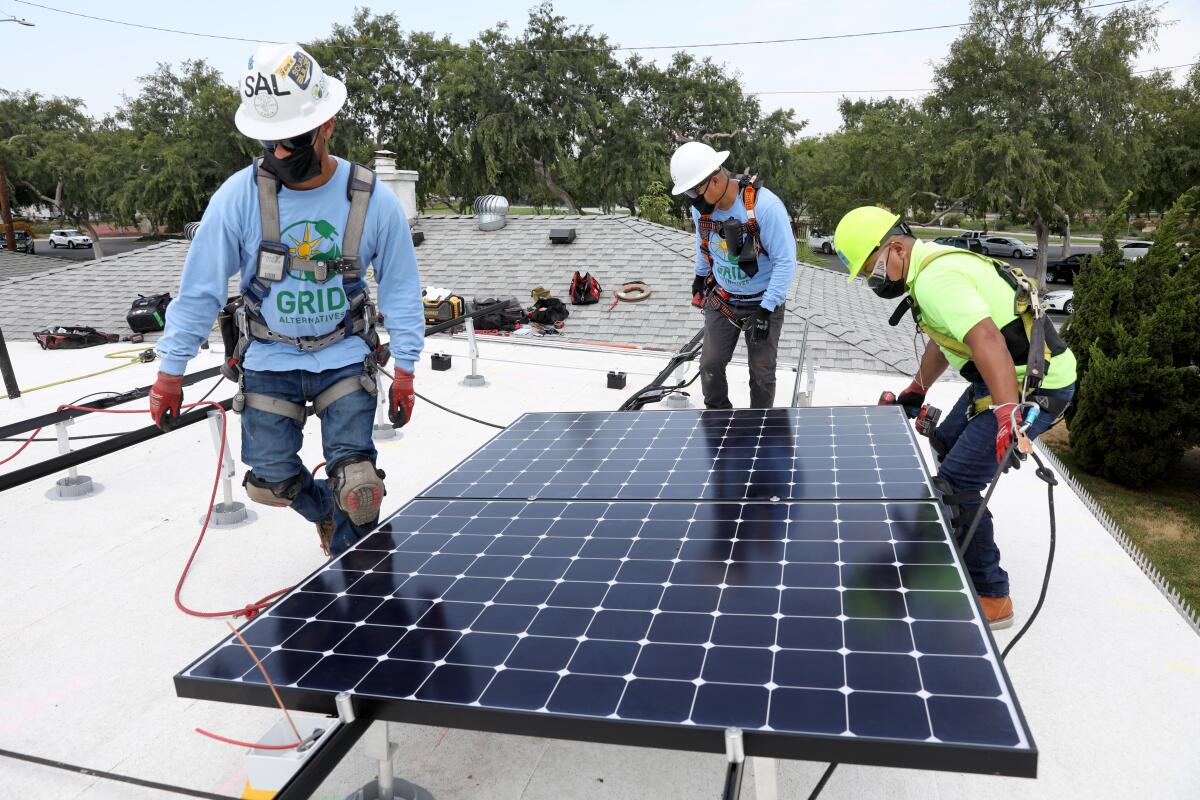
The CSLB’s 11-3 vote reversed the board’s earlier judgment that firms with C-46 solar contractor’s licenses could install batteries paired with solar panels. Del Chiaro said the about-face is especially damaging because homes and businesses that want solar increasingly want energy storage, too, to protect against wildfire-driven power outages and the threat of rolling blackouts.
When I called up folks on the other side of the debate to ask about all this, I got an entirely different version of events.
Eddie Bernacchi, a lobbyist for the National Electrical Contractors Assn., told me this is “a dispute between electrical contractors and solar contractors over jurisdiction,” not a union vs. nonunion issue. Requiring solar-plus-storage projects to be installed by contractors with certified electricians, he said, would not only improve safety, it would lead to higher wages in the solar industry.
“The electrical contractors offer a path to higher wages and a real career,” Bernacchi said.
Tom Enslow, an attorney representing the contractors association and IBEW, made a similar case. He said that while the new rule would allow union shops to better compete in the solar market, CSLB’s decision was “more about safety and precedent.”
“What’s happened is that the solar industry started pushing a theory that, hey, as long as we install an energy storage system at the same time, we should be allowed to do that work,” Enslow said. “It’s pretty clear they are separate systems.”
Those arguments seemingly convinced the state board. Nancy Springer, the chief building official for Sacramento County, said she and her fellow board members “have to be aware of protecting the consumers and making sure that they’re installed properly, and that people have the proper training.” Board member Johnny Simpson, who previously led an IBEW local and was appointed by the Senate Rules Committee, responded to calls for more debate by saying, “It’s time to put this issue to bed.”
I also spoke with Carol Zabin, who leads the UC Berkeley Labor Center’s Green Economy Program and co-authored a report that helped prompt CSLB’s decision. She said she and her team — which included a chemical safety expert — found little difference between the cost of a solar system installed by a firm using certified electricians and a firm not using certified electricians.
“It’s about whether you want a certified workforce or not,” Zabin said. “They have no certifications in that industry.”
Suffice to say the solar industry pushed back against those claims, hard.
Barry Cinnamon, CEO of Bay Area solar and battery installer Cinnamon Energy Systems, said the idea that companies like his don’t train their workers to handle energy storage systems is absurd. The companies that manufacture lithium-ion batteries — such as Enphase, LG and Tesla — also require workers who install their products to sit for several hours of training, Cinnamon said.
“You have to be trained, or they won’t sell you the battery,” he said.
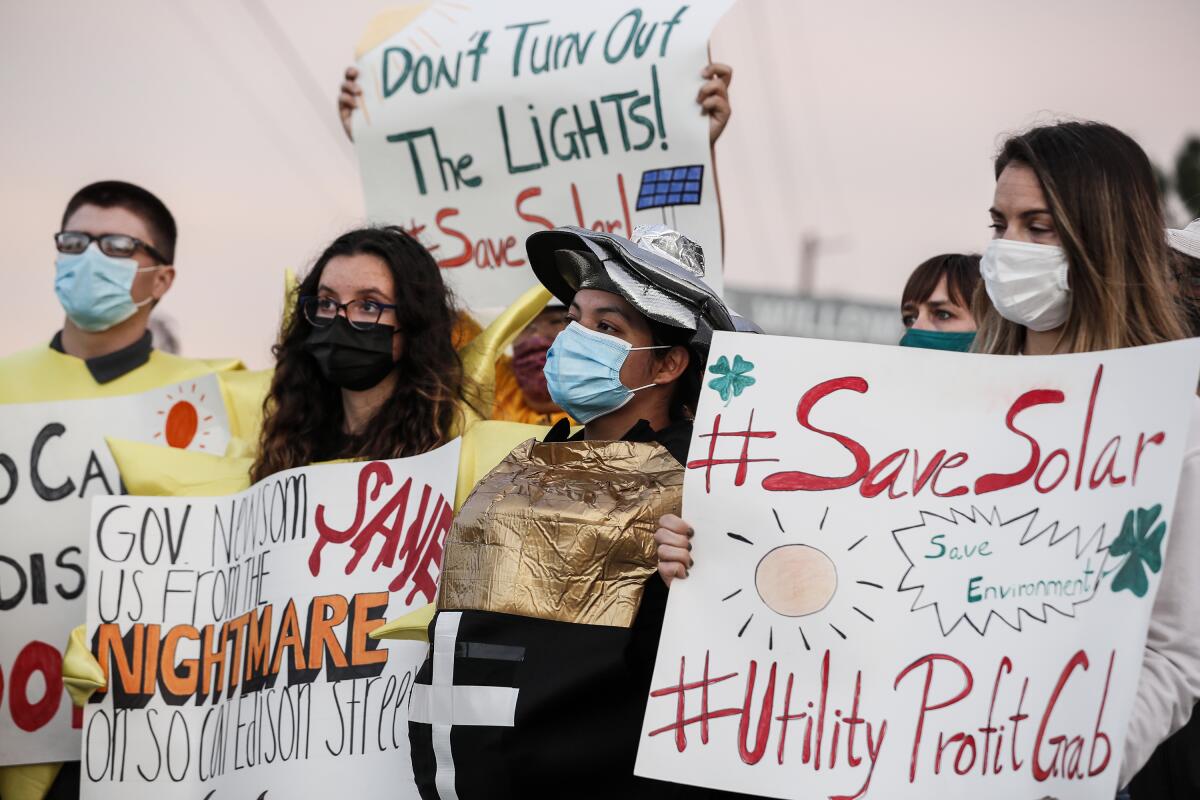
By now, you’re probably wondering whether batteries really can be safety hazards. The answer: “Yes, but...”
Yes, but 60,000 residential batteries have been installed in California, and nobody can cite a single example of a serious safety incident. There was an explosion that injured first responders in Arizona, and more recently an overheating issue that resulted in the world’s largest battery facility, in Moss Landing, Calif., being shut down at least temporarily. But those problems involved large lithium-ion battery banks operated by utilities or big energy companies, not home batteries installed by solar contractors.
The UC Berkeley Labor Center’s report acknowledged that “there have been no significant incidents with injury or death that we could identify.” Still, the authors wrote, there are “significant data gaps that preclude definitive statements that risks are low.”
To Del Chiaro, fires ignited by power lines are a much bigger safety threat — and rooftop solar can limit the need for those lines, at least somewhat. She also pointed out that the utilities who own those lines — Pacific Gas & Electric, Southern California Edison and San Diego Gas & Electric — all submitted letters supporting the idea of barring solar contractors from installing batteries.
“Who is burning down the state and killing people? It’s PG&E and the other utilities,” Del Chiaro said. “We are the solution to that. We are keeping people’s homes lit. We’re keeping them safe when they need it, and solving climate change.”
CSLB agreed to delay enforcement of the rule after the California Solar and Storage Assn. filed suit, claiming the board had failed to conduct a formal rulemaking. But now CSLB is gearing up for that rulemaking, with an agenda item scheduled for Nov. 29.
To say this debate has gotten bitter is an understatement. Groups on both sides are furious with their opponents and can’t even agree on basic facts. There are many points of disagreement I haven’t gotten into here: How easy would it be for rooftop solar installers to get new licenses and hire certified electricians, and would doing so really cause prices to rise? How many companies would be affected by the new rule? What are the true wage differences between union and nonunion solar jobs?
As I’ve written previously, the labor movement can be a positive force for change in the clean energy transition. But there are also many examples of unions protecting the fossil-fueled status quo when they feel their livelihoods depend on it.
The feud between electrical workers and rooftop solar installers is more nuanced. But it offers a blunt reminder that the labor movement can make or break California’s climate policies. How exactly the state reduces emissions, and who benefits — that’s up for grabs. And whether it happens fast enough to stave off the worst wildfires and heat waves on the horizon is uncertain.
Here’s what else is happening around the West:
TOP STORIES
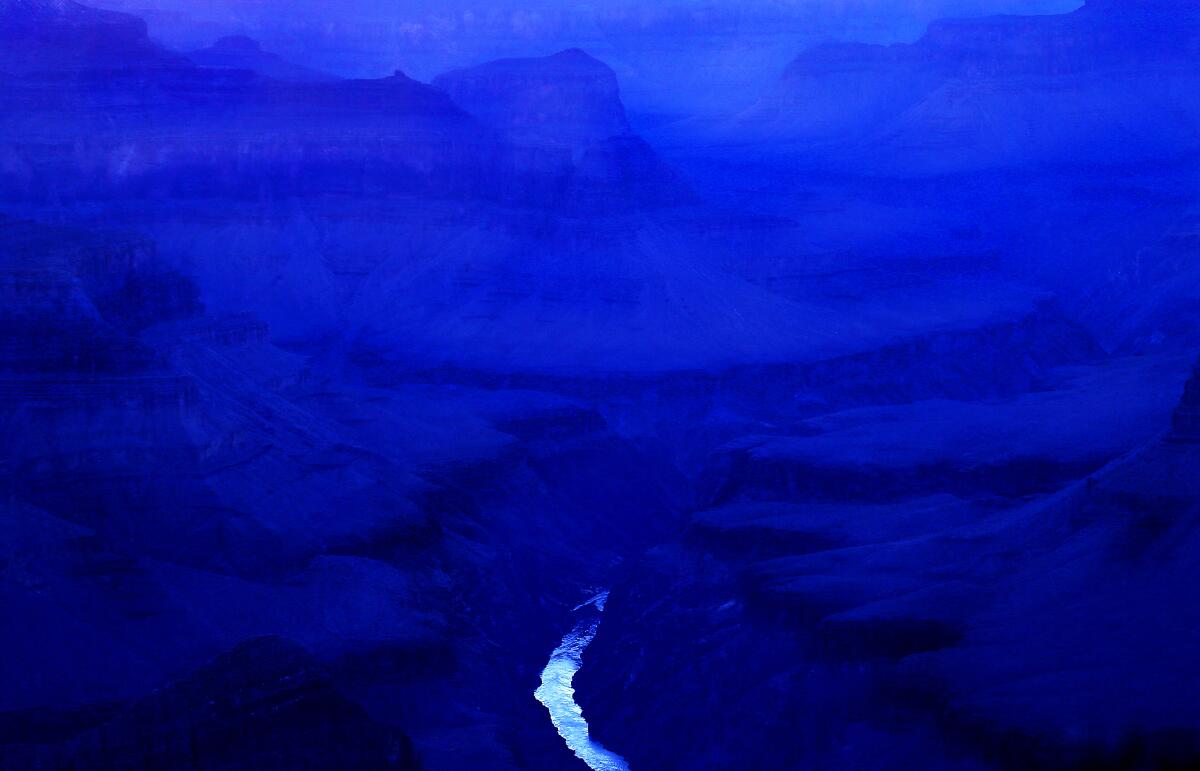
The Metropolitan Water District declared a drought emergency in Southern California. Details here from The Times’ Ian James, who notes that the declaration is especially focused on areas that rely heavily (or entirely) on supplies from the Sacramento and San Joaquin rivers. While recent storms bolstered reservoirs and brought fire relief, the big question now is how much rain we’ll get through March, Lila Seidman writes. See also this piece by Ian and Jaweed Kaleem, with stunning photos by Luis Sinco, about the Colorado River, which one expert calls “the best example globally of how things can go badly” on water resilience.
A fire in Klamath National Forest burned through areas treated with prescribed burns and thinning. Patches of forest that received the most treatment seem to have fared the best — some of the strongest evidence yet for the practice, Alex Wigglesworth writes. See also this lovely photo essay by Robert St. John, with images by the AP’s Noah Berger, on efforts to save giant sequoias by planting seeds from some of the largest, oldest trees, in hopes that their offspring can survive our hotter, more fiery planet.
“Every activist has a story to tell, every story has a solution to give, every solution has a life to change.” I loved this deeply reported piece about young activists in Uganda, India and Scotland taking the rich and powerful to task on the climate crisis, by my colleagues Emily Baumgaertner, Kate Linthicum and Parth M.N. Alas, those activists are almost certainly unsatisfied with the Glasgow climate summit, which thus far has produced only incremental progress, Anna M. Phillips and Chris Megerian report.
DROUGHT CENTRAL
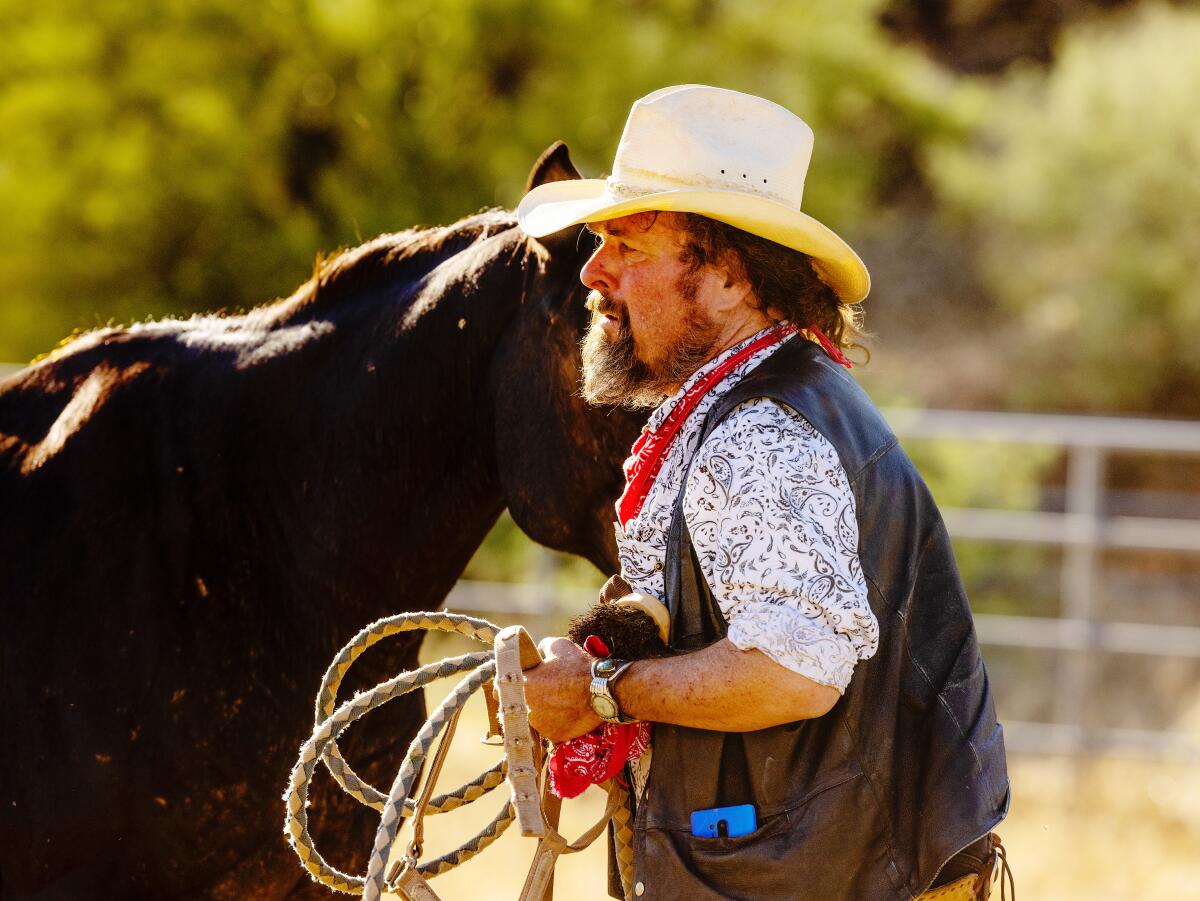
In Arizona, an unusual rancher is trying to crossbreed cattle to produce less methane gas and better withstand drought. He’s not the only one looking to reduce the climate impacts of beef, my colleague Jaweed Kaleem writes. In California, meanwhile, officials are launching a $50-million grant program to help farmers convert fallowed fields to wildlife habitat, groundwater banks, floodplains, solar plants or other uses, in part to prevent a new Dust Bowl, Dustin Gardiner reports for the San Francisco Chronicle.
Conservationists, tribal leaders and air regulators are calling on Los Angeles to stop diverting water from Mono Lake. They say dust storms are getting worse after two years of drought, and Angelenos have gotten so good at conservation that they no longer need the water, Louis Sahagún reports for The Times. City officials counter that the dust storms may have other causes.
Migratory birds and freshwater fish are suffering as rivers and wetlands dry up. Writing for CalMatters, Julie Cart examines the consequences of drought for birds traveling the Pacific Flyway, finding that especially in California’s northern reaches, a lack of water has had devastating consequences for ducks, geese, eagles and herons. And in the Sacramento River, nearly an entire run of juvenile Chinook salmon was killed this summer by high water temperatures, Nick Cahill reports for Courthouse News Service.
AROUND THE WEST
“There are few things worse than losing a special place the first time but one of them is losing it a second time.” The Salt Lake Tribune’s Zak Podmore wrote about the canyons, rapids and artifacts that are reemerging along the Colorado River as Lake Powell recedes, and the case for prioritizing higher water levels at Lake Mead rather than straining to prop up both reservoirs.
The Imperial Irrigation District bulldozed berms, nesting sites and pipes at the Red Hill Bay habitat restoration project along the shore of the Salton Sea. The Desert Sun’s Janet Wilson explains what the heck is going on, but suffice to say this is a bizarre and unfortunate turn of events, no matter who you blame. Six years ago last week I was at the groundbreaking for Red Hill Bay, which was supposed to launch a new era of real action to support fish and bird species and limit toxic dust emissions.
It’s still not clear when the god-awful smell in Carson will go away, with L.A. County officials saying it could cost up to $358 million (!) to clean up. Some locals are skeptical that decaying organic matter alone is to blame, my colleague Jaclyn Cosgrove reports. Measurements of hydrogen sulfide, known for its rotten egg stench, at one point reached 7,000 parts per billion — far more than the recent high of 250 parts per billion at the infamously smelly Salton Sea, Ian James and Andrew J. Campa report.
THE ENERGY TRANSITION
The California Public Utilities Commission will allow Southern California Gas to store additional fuel at Aliso Canyon. The Times’ Gregory Yee wrote about the displeasure of Porter Ranch residents who still don’t feel safe around the gas storage field, which sprung a record-breaking methane leak in 2015. See also this piece from last month on lingering questions surrounding the health consequences of the leak, and this edition of Boiling Point checking in on Gov. Gavin Newsom’s pledge to close the facility.
Oklahoma Natural Gas wants to charge a $1,400 “exit fee” to residential customers who ditch gas heating and cooking to go all-electric. It’s the latest effort by the gas utility industry and pro-fossil fuel public officials to block building electrification, Alexander C. Kaufman writes for HuffPost. As I’ve written previously, SoCalGas is fighting to protect natural gas here in California.
A new study by Stanford and MIT researchers finds California could cut emissions from the electric grid by 10%, save $21 billion and spare 90,000 acres from energy development by keeping the Diablo Canyon nuclear plant open past 2025. I’m guessing absolutely no one with a preexisting opinion on nuclear power will be moved by this, but details here from Reuters’ Timothy Gardner if you’re interested. Also check out this great deep dive by the Seattle Times’ Hal Bernton on the future of the U.S. nuclear energy industry, including a discussion of how challenging it can be to phase power production up and down at nuclear plants.
POLITICAL CLIMATE
As you may have heard, the House of Representatives passed a $1-trillion bipartisan infrastructure bill. It now awaits President Biden’s signature, The Times’ Jennifer Haberkorn reports. For a breakdown of the climate and clean energy investments in the bill — of which there are more than $80 billion — see this excellent piece by Jeff St. John for Canary Media. The legislation also includes a bunch of money to support national parks and other public lands, including $350 million to reduce wildlife-vehicle collisions, Kurt Repanshek writes for National Parks Traveler. Other funds will go toward coping with the effects of climate change, including ensuring access to clean drinking water, Coral Davenport and Christopher Flavelle report for the New York Times.
The U.S. and 18 other nations have signed the Clydebank Declaration, an agreement to establish zero-emission shipping routes. Cargo ships are a major contributor to global warming, my colleague Anna M. Phillips reports, potentially making this one of the more consequential deals reached at the Glasgow climate summit. It’s a deal that could be especially beneficial at the ports of L.A. and Long Beach, where an ongoing cargo jam may be spewing higher levels of pollution into nearby neighborhoods.
A new report finds that brokers, legitimate recycling companies and organized crime groups are evading rules banning the export of hard-to-recycle plastic scrap to many countries, benefiting the wealthy nations where it’s produced. Yikes. Here’s the story from Anna M. Phillips, who writes that the plastic we think we’re recycling often ends up as pollution overseas.
ONE MORE THING

Not only did “Last Week Tonight” host John Oliver do an entire segment on the power grid, he used an explanation of the United States’ three main grids to make fun of the cheating Houston Astros. I won’t spoil the joke. But it was extremely my jam.
We’ll be back in your inbox next week. If you enjoyed this newsletter, please consider forwarding it to your friends and colleagues.




